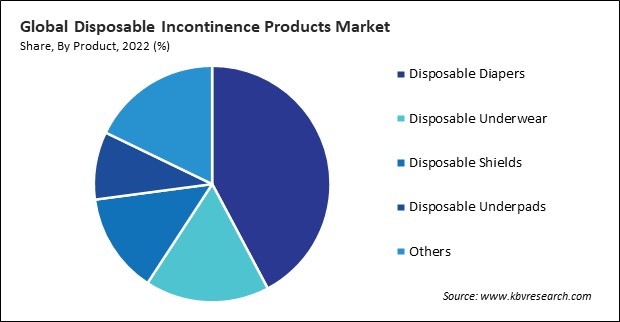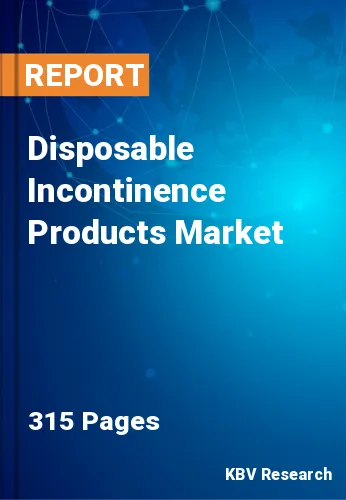“Global Disposable Incontinence Products Market to reach a market value of USD 18.7 Billion by 2030 growing at a CAGR of 6.1%”
The Global Disposable Incontinence Products Market size is expected to reach $18.7 billion by 2030, rising at a market growth of 6.1% CAGR during the forecast period. In the year 2022, the market attained a volume of 2,624.7 million units, experiencing a growth of 5.4% (2019-2022).
North America, like many regions, has been experiencing a demographic shift with an aging population. Therefore, the North America region acquired $4,290.5 million in 2022. As people age, they may face health challenges, including urinary incontinence, a common issue among the elderly. With an aging population, there is likely to be an increased awareness of healthcare needs, including conditions like incontinence. This awareness can drive individuals and healthcare providers to seek effective solutions, leading to a higher demand for disposable incontinence products.

The aging population worldwide is expanding, with many individuals entering the elderly demographic. As people age, the likelihood of experiencing incontinence-related challenges tends to increase, creating a substantial market for products that address these issues. There is a common correlation between advancing age and an increased prevalence of incontinence issues, such as urinary and fecal incontinence. The physiological changes accompanying aging, such as weakened pelvic muscles and reduced bladder control, contribute to incontinence among the elderly. Additionally, this age-related association further fuels the demand for products, as they become essential in managing incontinence in older individuals with chronic diseases. The growing awareness of healthcare and hygiene, coupled with the recognition of the impact of chronic diseases on incontinence, drives individuals to seek effective solutions. This offer a practical and hygienic response to the challenges posed by chronic conditions, contributing to their increased demand. As a result, these aspects will pose lucrative growth prospects for the market.
However, it can impose a financial burden on individuals, especially those living on fixed incomes, such as retirees or individuals with disabilities. The recurring expense of purchasing disposable products can strain budgets, limiting the ability of some individuals to afford these essential items. Affordability concerns may result in individuals limiting their use of this. Individuals might sometimes resort to using the products sparingly or only in specific situations due to cost considerations. This can compromise their comfort and overall well-being. The reluctance or inability to consistently use this due to cost concerns may have implications for the health outcomes of affected individuals. Inadequate management of incontinence can lead to hygiene issues, skin irritation, and other related health complications. Thus, these aspects can hamper the growth of the market.
Furthermore, companies within the market encountered obstacles pertaining to disturbances in the manufacturing procedures and supply chain. Safety concerns among the workforce, movement restrictions, and lockdowns contributed to these difficulties. Lockdowns, restrictions on movement, and safety concerns among the workforce contributed to these challenges. Companies had to adapt swiftly to the changing dynamics, implement safety measures, and optimize their operations to meet the escalating demand. The healthcare sector's focus on addressing the COVID-19 crisis diverted attention and resources away from other medical conditions, including incontinence-related ones. This influenced the development and marketing of this during the past phases of the pandemic. Thus, the COVID-19 pandemic had a negative impact on the market.
Based on product, the market is segmented into disposable underwear, disposable shields, disposable diapers, disposable underpads, and others. In 2022, the disposable diapers segment garnered the highest revenue share in the market. Disposable diapers offer a convenient solution for individuals with incontinence issues. They are easy to use, require no washing or maintenance, and can be disposed of after use. This convenience factor is particularly appealing to caregivers and individuals seeking a hassle-free option. Thus, these factors will boost the demand in the segment.

On the basis of incontinence type, the market is divided into stress urinary incontinence, urge urinary incontinence, overflow urinary incontinence, and functional urinary incontinence. In 2022, the overflow urinary incontinence segment witnessed a substantial revenue share in the market. Overflow urinary incontinence can be associated with conditions such as enlarged prostate in men or pelvic organ prolapse in women. As awareness of different types of incontinence increases, more individuals may be diagnosed with overflow incontinence. This, in turn, can drive demand for disposable products tailored to managing this condition. Therefore, the segment will witness increased demand in the coming years.
Free Valuable Insights: Global Disposable Incontinence Products Market size to reach USD 18.7 Billion by 2030
By region, the market is segmented into North America, Europe, Asia Pacific, and LAMEA. In 2022, the Europe segment acquired a considerable revenue share in the market. In Europe, there has been a growing awareness of incontinence-related concerns and efforts to reduce the stigma associated with these issues. As awareness increases, more individuals may use disposable incontinence products. Hence, owing to these aspects, the segment will witness increased growth in the segment.
| Report Attribute | Details |
|---|---|
| Market size value in 2022 | USD 11.7 Billion |
| Market size forecast in 2030 | USD 18.7 Billion |
| Base Year | 2022 |
| Historical Period | 2019 to 2021 |
| Forecast Period | 2023 to 2030 |
| Revenue Growth Rate | CAGR of 6.1% from 2023 to 2030 |
| Quantitative Data | Volume in Million units, Revenue in USD Billion, and CAGR from 2019 to 2030 |
| Number of Pages | 315 |
| Number of Tables | 570 |
| Report coverage | Market Trends, Revenue Estimation and Forecast, Segmentation Analysis, Regional and Country Breakdown, Porter’s 5 Forces Analysis, Company Profiling, Companies Strategic Developments, SWOT Analysis, Winning Imperatives |
| Segments covered | Product, Incontinence Type, Region |
| Country scope |
|
| Companies Included | Asahi Kasei Corporation, Berry Global Group, Inc., Cardinal Health, Inc., Domtar, Inc., First Quality Enterprises, Inc., Freudenberg SE, Georgia-Pacific LLC (Koch Industries, Inc), Kimberly-Clark Corporation, Unicharm Corporation, Ahlstrom |
By Incontinence Type (Volume, Million Units, USD Billion, 2019-2030)
By Product (Volume, Million Units, USD Billion, 2019-2030)
By Geography (Volume, Million Units, USD Billion, 2019-2030)
This Market size is expected to reach $18.7 billion by 2030.
Rising aging population worldwide are driving the Market in coming years, however, Cost considerations of disposable incontinence products restraints the growth of the Market.
Asahi Kasei Corporation, Berry Global Group, Inc., Cardinal Health, Inc., Domtar, Inc., First Quality Enterprises, Inc., Freudenberg SE, Georgia-Pacific LLC (Koch Industries, Inc), Kimberly-Clark Corporation, Unicharm Corporation, Ahlstrom
In the year 2022, the market attained a volume of 2,624.7 million units, experiencing a growth of 5.4% (2019-2022).
The Stress Urinary Incontinence segment is leading the Market, by Incontinence Type in 2022; there by, achieving a market value of $7.2 billion by 2030.
The North America region dominated the Market, by region in 2022, and would continue to be a dominant market till 2030; thereby, achieving a market value of $6.5 billion by 2030.
Our team of dedicated experts can provide you with attractive expansion opportunities for your business.

 Drivers
Drivers
 Restraints
Restraints
 Opportunities
Opportunities
 Challenges
Challenges
